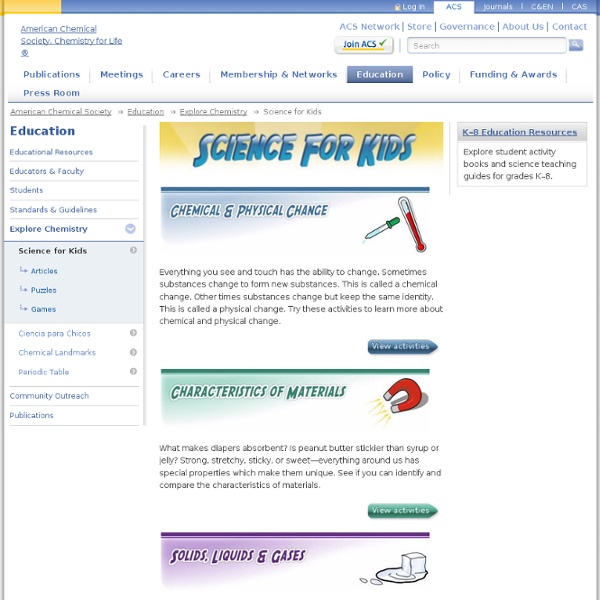



Virtual Labs The Virtual Lab is an online simulation of a chemistry lab. It is designed to help students link chemical computations with authentic laboratory chemistry. The lab allows students to select from hundreds of standard reagents (aqueous) and manipulate them in a manner resembling a real lab. More information and offline downloads. Please scroll below to find our collection of pre-written problems, they have been organized by concept and ranked by difficulty. Stoichiometry The Mole, Molarity, and Density Glucose Dilution Problem In this activity, students use the virtual lab to create a 0.025M glucose solution from a standard 1M glucose solution.
Household Science for Kids: Slime & Polymers What's going on? When you mix Elmer's glue with a bit of water, you make a substance that is known as a polymer (polyvinyl acetate) and that the borax solution (sodium tetraborate) is a 'cross-linking' substance that binds the polymer chains together to make the glue solution thicker. So, as the polymer chains get more 'bound-together', it gets harder for them to move around, and your slime starts to be more like Silly-putty™. Experiment with adding more borax solution to see if this indeed makes the slime thicker or thinner. Knowing just how much Borax solution to add is the trick to this experiment. If you add too little, your slime will contain excess glue (the polymer part) and it will be sticky. The substance known as 'Gak™' is really a specialized form of a polymer known as Poly-vinyl Alcohol, but is not too far off what we made with Elmer's glue.
Home Common Compound Library A searchable database of over 800 common compound names, formulas, structures, and properties. Companion Notes Hyperlinked notes and guides for first semester general chemistry. Construction Kits Flash-based kits for building chemical formulas, names, equations, and problem solutions. Articles Featured articles, books, and tutorials. Toolbox Interactive graphing, popup tables, and calculators. Tutorials Index of self-guided tutorials, quizzes, and drills on specific topics. Children Science Links-Kids' Resources ChemCollective Cornstarch Packing Peanuts - The Guilt Free Art Project for Kids | Straight Dope Dad | A Father's View on Parenting Summary: Art projects often mean just creating more junk to throw away. Not the same day of course, but eventually. Here’s something you can feel good about tossing. Our latest cornstarch packing peanut creations. Going clockwise from left to right: Two legged dinosaur eating man, big long neck dinosaur fighting man, triceratops gouging man, small tyrannosaurus rex, and giant tarantula attacking man. Though my partner had experimented with them while she was a preschool teacher, my first introduction the art project potential of the cornstarch packaging peanut was at The Children’s Discovery Museum in San Jose. We made little dinosaurs and we just had a blast. These cornstarch packing peanuts are just amazing. They’re 100% biodegradable and edible. To build your sculptures all you need is a plate or bowl with a damp sponge or damp paper towel in it, some sheets of cardboard for the base (cereal boxes will work great) and some packing peanuts. Detail of triceratops gouging man.
Welcome to the Chemical Education Digital Library Cool Science Experiments for Kids: Water's Skin & Surface Tension | ExpertVillage Videos In this free instructional video clip series, our expert will demonstrate a popular children's science experiment called Water's Skin (surface tension). Water's surface tension is characterized by an elastic-type sheet on the edge of the liquid. In physics, this phenomenon is known as water's skin, as the thin layer of “skin” allows certain insects, small metal objects and other minuscule things to seemingly walk on water. A paper clip, for example, may float on the top layer of water calmly, causing a capillary action. It is easy to see why such a phenomenon would be interesting to kids, especially children with any sort of interest in science or biology. How to Release Surface Tension Watch as the soap causes the paper clips to sink in this free home science video How to Place the Paper Clips for the Water Surface for the Tension Experiment How to place the paper clips on the water's surface for the tension experiment in this free home science video
Middle School Chemistry | Download Free Science Activities, Access Chemistry Multimedia, Find Information on Workshops HowStuffWorks "Easy Outdoor Science Experiments For Kids" Finding out about the world around you is even more fun when you try these easy outdoor science experiments for kids. What could be better than a day spent outdoors, exploring your environment? Whether you're discovering something about your own backyard or collecting rocks from outer space, the experiments found in the following articles will give you hours of entertainment. It doesn't matter if it's raining or sunny, day or night -- we have it covered. Check these out: Leaf Scents Did you know that leaves have their own special scents? Wind Detective Be a "wind detective" to discover how breezy or blustery the day is. Cricket Degrees Crickets are nature's thermometers. Lawn Census Do you know what's living in your lawn? Can Rocks Float? Do all rocks sink to the bottom of a lake or stream? It Came From Outer Space No, it's not a space alien, but it does come from outer space. Sun-Baked Want to see a good reason to wear sunscreen? Raincoats for Cotton Balls Let a cotton ball be your guide!
Chemistry help, high school chemistry, college chemistry, chemistry tutorial, chemistry